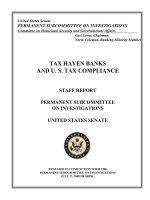wall street & the financial cri - permanent subcommittee on inves
Bạn đang xem bản rút gọn của tài liệu. Xem và tải ngay bản đầy đủ của tài liệu tại đây (7.34 MB, 2,997 trang )
SENATOR CARL LEVIN
Chairman
SENATOR TOM COBURN, M.D.
Ranking Minority Member
PERMANENT SUBCOMMITTEE
ON INVESTIGATIONS
ELISE J. BEAN
Staff Director and Chief Counsel
ROBERT L. ROACH
Counsel and Chief Investigator
LAURA E. STUBER
Counsel
ZACHARY I. SCHRAM
Counsel
DANIEL J. GOSHORN
Counsel
DAVID H. KATZ
Counsel
ALLISON F. MURPHY
Counsel
ADAM C. HENDERSON
Professional Staff Member
PAULINE E. CALANDE
SEC Detailee
MICHAEL J. MARTINEAU
DOJ Detailee
CHRISTOPHER J. BARKLEY
Staff Director to the Minority
ANTHONY G. COTTO
Counsel to the Minority
KEITH B. ASHDOWN
Chief Investigator to the Minority
JUSTIN J. ROOD
Senior Investigator to the Minority
VANESSA CAREIRO
Law Clerk
BRITTANY CLEMENT
Law Clerk
DAVID DeBARROS
Law Clerk
ERIN HELLING
Law Clerk
HELENA MAN
Law Clerk
JOSHUA NIMMO
Intern
ROBERT PECKERMAN
Intern
TANVI ZAVERI
Law Clerk
MARY D. ROBERTSON
Chief Clerk
Permanent Subcommittee on
Investigations
199 Russell Senate Office Building
– Washington, D.C. 20510
Main Number: 202/224-9505
Web Address:
www.hsgac.senate.gov [Follow Link to
“Subcommittees,” to “Investigations”]
Contents
I. EXECUTIVE SUMMARY
A. Subcommittee Investigation
B. Overview
(1) High Risk Lending: Case Study
of Washington Mutual Bank
(2) Regulatory Failures: Case Study
of the Office of Thrift Supervision
(3) Inflated Credit Ratings: Case
Study of Moody’s and Standard &
Poor’s
(4) Investment Bank Abuses: Case
Study of Goldman Sachs and Deutsche
Bank
C. Recommendations
II. BACKGROUND
A. Rise of Too-Big-To-Fail U.S.
Financial Institutions
B. High Risk Mortgage Lending
C. Credit Ratings and Structured
Finance
D. Investment Banks
E. Market Oversight
F. Government Sponsored
Enterprises
G. Administrative and Legislative
Actions
H. Financial Crisis Timeline
III. HIGH RISK LENDING: CASE
STUDY OF WASHINGTON MUTUAL
BANK
A. Subcommittee Investigation and
Findings of Fact
B. Background
(1) Major Business Lines and Key
Personnel
(2) Loan Origination Channels
(3) Long Beach
(4) Securitization
(5) Overview of WaMu’s Rise and
Fall
C. High Risk Lending Strategy
(1) Strategic Direction
(2) Approval of Strategy
(3) Definition of High Risk Lending
(4) Gain on Sale
(5) Acknowledging Unsustainable
Housing Price Increases
(6) Execution of the High Risk
Lending Strategy
D. Shoddy Lending Practices
(1) Long Beach
(2) WaMu Retail Lending
(a) Inadequate Systems and Weak
Oversight
(b) Risk Layering
(c) Loan Fraud
(d) Steering Borrowers to High Risk
Option ARMs
(e) Marginalization of WaMu Risk
Managers
E. Polluting the Financial System
(1) Long Beach and WaMu
Securitizations
(2) Deficient Securitization
Practices
(3) Securitizing Delinquency-Prone
Loans
(4) WaMu Loan Sales to Fannie Mae
and Freddie Mac
F. Destructive Compensation
Practices
(1) Sales Culture
(2) Paying for Speed and Volume
(a) Long Beach Account Executives
(b) WaMu Loan Consultants
(c) Loan Processors and Quality
Assurance Controllers
(3) WaMu Executive Compensation
G. Preventing High Risk Lending
(1) New Developments
(2) Recommendations
1. Ensure “Qualified Mortgages”
Are Low Risk
2. Require Meaningful Risk
Retention
3. Safeguard Against High Risk
Products
4. Require Greater Reserves for
Negative Amortization Loans
5. Safeguard Bank Investment
Portfolios
IV. REGULATORY FAILURE:
CASE STUDY OF THE OFFICE OF
THRIFT SUPERVISION
A. Subcommittee Investigation and
Findings of Fact
B. Background
(1) Office of Thrift Supervision
(2) Federal Deposit Insurance
Corporation
(3) Examination Process
C. Washington Mutual Examination
History
(1) Regulatory Challenges Related to
Washington Mutual
(2) Overview of Washington
Mutual’s Ratings History and Closure
(3) OTS Identification of WaMu
Deficiencies
(a) Deficiencies in Lending
Standards
(b) Deficiencies in Risk
Management
(c) Deficiencies in Home Appraisals
(d) Deficiencies Related to Long
Beach
(e) Over 500 Deficiencies in 5
Years
(4) OTS Turf War Against the FDIC
D. Regulatory Failures
(1) OTS’ Failed Oversight of WaMu
(a) Deference to Management
(b) Demoralized Examiners
(c) Narrow Regulatory Focus
(d) Inflated CAMELS Ratings
(e) Fee Issues
(2) Other Regulatory Failures
(a) Countrywide
(b) IndyMac
(c) New Century
(d) Fremont
E. Preventing Regulatory Failures
(1) New Developments
(2) Recommendations
1. Complete OTS Dismantling
2. Strengthen Enforcement
3. Strengthen CAMELS Ratings
4. Evaluate Impacts of High Risk
Lending
V. INFLATED CREDIT RATINGS:
CASE STUDY OF MOODY’S AND
STANDARD & POOR’S
A. Subcommittee Investigation and
Findings of Fact
B. Background
(1) Credit Ratings Generally
(2) The Rating Process
(3) Record Revenues
C. Mass Credit Rating Downgrades
(1) Increasing High Risk Loans and
Unaffordable Housing
(2) Mass Downgrades
D. Ratings Deficiencies
(1) Awareness of Increasing Credit
Risks
(2) CRA Conflicts of Interest
(a) Drive for Market Share
(b) Investment Bank Pressure
(3) Inaccurate Models
(a) Inadequate Data
(b) Unclear and Subjective Ratings
Process
(4) Failure to Retest After Model
Changes
(5) Inadequate Resources
(6) Mortgage Fraud
E. Preventing Inflated Credit Ratings
(1) Past Credit Rating Agency
Oversight
(2) New Developments
(3) Recommendations
1. Rank Credit Rating Agencies by
Accuracy
2. Help Investors Hold CRAs
Accountable
3. Strengthen CRA Operations
4. Ensure CRAs Recognize Risk
5. Strengthen Disclosure
6. Reduce Ratings Reliance
VI. INVESTMENT BANK
ABUSES: CASE STUDY OF
GOLDMAN SACHS AND DEUTSCHE
BANK
A. Background
(1) Investment Banks In General
(2) Roles and Duties of an
Investment Bank: Market Maker,
Underwriter, Placement Agent, Broker-
Dealer
(3) Structured Finance Products
B. Running the CDO Machine: Case
Study of Deutsche Bank
(1) Subcommittee Investigation and
Findings of Fact
(2) Deutsche Bank Background
(3) Deutsche Bank’s $5 Billion
Short
(a) Lippmann’s Negative Views of
Mortgage Related Assets
(b) Building and Cashing in the $5
Billion Short
(4) The “CDO Machine”
(5) Gemstone
(a) Background on Gemstone
(b) Gemstone Asset Selection
(c) Gemstone Risks and Poor
Quality Assets
(d) Gemstone Sales Effort
(e) Gemstone Losses
(6) Other Deutsche Bank CDOs
(7) Analysis
C. Failing to Manage Conflicts of
Interest: Case Study of Goldman Sachs
(1) Subcommittee Investigation and
Findings of Fact
(2) Goldman Sachs Background
(3) Overview of Goldman Sachs
Case Study
(a) Overview of How Goldman
Shorted the Subprime Mortgage Market
(b) Overview of Goldman’s CDO
Activities
(4) How Goldman Shorted the
Subprime Mortgage Market
(a) Starting $6 Billion Net Long
(b) Going Past Home: Goldman’s
First Net Short
(c) Attempted Short Squeeze
(d) Building the Big Short
(e) “Get Down Now”
(f) Profiting from the Big Short:
Making “Serious Money”
(g) Goldman’s Records Confirm
Large Short Position
(i) TopSheets
(ii)Risk Reports
(h) Profiting From the Big Short
(5) How Goldman Created and
Failed to Manage Conflicts of Interest in
its Securitization Activities
(a) Background
(i) Goldman’s Securitization
Business
(ii) Goldman’s Negative Market
View
(iii) Goldman’s Securitization Sell
Off
AA. RMBS Sell Off
BB. CDO Sell Off
CC. CDO Marks
DD. Customer Losses
(b) Goldman’s Conflicts of Interest
(i) Conflicts of Interest Involving
RMBS Securities
(ii) Conflicts of Interest Involving
Sales of CDO Securities
AA. Hudson Mezzanine Funding
2006-1
BB. Anderson Mezzanine Funding
2007-1
CC. Timberwolf I
DD. Abacus 2007-AC1
(iii) Additional CDO Conflicts of
Interest
AA. Liquidation Agent in Hudson 1
BB. Collateral Put Provider in
Timberwolf
(6) Analysis of Goldman’s Conflicts
of Interest
(a) Securities Laws
(b) Analysis
(i) Claiming Market Maker Status
(ii) Soliciting Clients and
Recommending Investments
(iii) Failing to Disclose Material
Adverse Information
(iv) Making Unsuitable Investment
Recommendations









